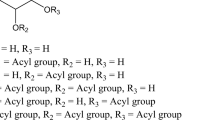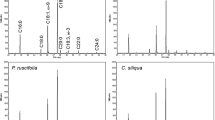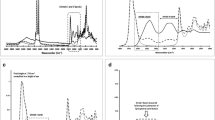Abstract
Three different analytical techniques, namely NMR spectroscopy, mass spectrometry and dynamic light scattering, were used to unravel the structure and morphology of polyglycerol polyricinoleate (PGPR). This material is used as an emulsifier in the preparation of chocolate and other confectionary products. The use of 1D and 2D NMR techniques led to the distinction of two separate entities in commercial ricinoleic acid (RA) and PGPR samples, namely the monomeric and oligomeric RA (estolides). 1H and 13C spectra of PGPR confirmed the presence of polyglycerol moieties of various lengths being esterified by RA and estolides and to a lesser extent by oleic and linoleic acids. 13C-NMR DOSY experiments demonstrated the occurrence of several species in PGPR. Electrospray Ionization and tandem Mass Spectrometry succeeded in identifying the presence of over 30 glycerol/polyglycerol species containing n glycerol moieties with n = 1–6 esterified by monomeric and oligomeric RA molecules. Dynamic light scattering contributed to the characterization of PGPR morphology. The PGPR mixture contains relatively small-sized entities (monomers, dimmers, trimmers) and larger aggregates resulted from chain association. The percentage of larger aggregates is minimal compared to small-sized species.







Similar content being viewed by others
References
Wilson R, van Shie BJ, Howes D (1998) Overview of the preparation, use and biological studies on polyglycerol polyricinoleate (PGPR). Food Chem Technol 36:711–718
Wilson R, Smith M (1998) Human studies on polyglycerol polyricinoleate (PGPR). Food Chem Technol 36:743–745
Bódalo A, Bastida J, Máximo MF, Montiel MC, Gómez M, Murcia MD (2008) Production of ricinoleic acid estolide with free and immobilized lipase from Candida rugosa. Biochem Eng J 39:450–456
Sahasrabudhe MR (1967) Chromatographic analysis of polyglycerols and their fatty acid esters. J Am Oil Chem Soc 44:376–378
Garti N, Aserin A (1981) Analyses of polyglycerol esters of fatty acids using high performance liquid chromatography. J Liq Chromatogr 4:1173–1194
Garti N, Aserin A (1982) Polyglycerol esters composition: theoretical random distribution versus HPLC analysis. J Am Oil Chem Soc 59:317–319
De Meulenaer B, Vanhoutte B, Heyghebaert A (2000) Combined liquid and gas chromatographic characterization of polyglycerol fatty acid esters. J Chromatogr 896:239–251
Chester TL, Innis DP (1986) Effect of free hydroxy groups in the separation of polyglycerol esters by capillary supercritical fluid chromatography. J High Resolut Chromatogr Chromatogr Commun 9:178–181
AOAC (1998) Official methods of analysis, Official methods 965.32.41.1.12, 969.17.33.6. 08, 16th edn, vol II and III
Lyerla JR, Levy GC (1974) Carbon-13 nuclear spin relaxation. In: Levy GC (ed) Topics in carbon-13 NMR spectroscopy. Wiley, New York, pp 100–101
Freeman R, Hill HDW, Kaptein R (1972) Proton-decoupled NMR. Spectra of carbon-13 with the nuclear overhauser effect suppressed. J Magn Reson 7:327–329
Berger S, Braun S (2004) 200 and more experiments: a practical course. Wiley VCH, Weinheim
Morris KF, Johnson CS Jr (1992) Diffusion-ordered two-dimensional nuclear magnetic resonance spectroscopy. J Am Chem Soc 114:3139–3141
Lin JT, Arcinas A, Harden LR, Fagerquist CK (2006) Identification of (12-ricinoleoyl ricinoleoyl) diricinoleoylglycerol, an acylglycerol containing four acyl chains, in castor (Ricinus communis L.) oil by LC-ESI-MS. J Agric Food Chem 54:3498–3504
Lin J-T, Arcinas A (2008) Regiospecific Identification of 2-(12-ricinoleoyl ricinoleoyl)-1,3-diricinoleoyl-sn-glycerol in castor (Ricinus communis L.) oil by ESI-MS. J Agric Food Chem 56:3616–3622
Hayes DG, Kleiman R, Weisleder D, Adlof RO, Cuperus FP, Derksen JTP (1995) The triglyceride composition, structure, and presence of estolides in the oils of Lesquerella and related species. Ind Crops Prod 4:295–301
Batrakov SG, Tolkachev ON (1997) The structures of triacylglycerols from sclerotia of the rye ergot Claviceps purpurea (Fries) Tul. Chem Phys Lipids 86:1–12
AOCS (2012) The lipid library. Lipid chemistry, biology, technology & Analysis. http://lipidlibrary.aocs.org/index.html
Vigli G, Philippidis A, Spyros A, Dais P (2003) Classification of edible oils by employing 31P and 1H NMR spectroscopy in combination with multivariate statistical analysis. A proposal for the detection of seed oil adulteration in virgin olive oils. J Agric Food Chem 51:5715–5722
Vlahov G (1999) Application of NMR to the study of olive oils. Progr Nucl Magn Reson Spectrosc 35:341–357
Jakes J (1988) Testing of the constrained regularization method of inverting Laplace transform on simulated very wide quasielastic light scattering autocorrelation functions. J Phys B 38:1305–1307
Author information
Authors and Affiliations
Corresponding author
Electronic supplementary material
Below is the link to the electronic supplementary material.
About this article
Cite this article
Orfanakis, A., Hatzakis, E., Kanaki, K. et al. Characterization of Polyglycerol Polyricinoleate Formulations Using NMR Spectroscopy, Mass Spectrometry and Dynamic Light Scattering. J Am Oil Chem Soc 90, 39–51 (2013). https://doi.org/10.1007/s11746-012-2137-4
Received:
Revised:
Accepted:
Published:
Issue Date:
DOI: https://doi.org/10.1007/s11746-012-2137-4




